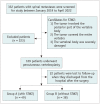Efficacy and Safety of the Safe Triangular Working Zone Approach in Percutaneous Vertebroplasty for Spinal Metastasis
- PMID: 35926840
- PMCID: PMC9434739
- DOI: 10.3348/kjr.2021.0914
Efficacy and Safety of the Safe Triangular Working Zone Approach in Percutaneous Vertebroplasty for Spinal Metastasis
Abstract
Objective: This study aimed to assess the technical feasibility, efficacy, and safety of the safe triangular working zone (STWZ) approach applied in percutaneous vertebroplasty (PV) for spinal metastases involving the posterior part of the vertebral body.
Materials and methods: We prospectively enrolled 87 patients who underwent PV for spinal metastasis involving the posterior part of the vertebral body, with or without the STWZ approach, from January 2019 to April 2022. Forty-nine patients (27 females and 22 males; mean age ± standard deviation [SD], 57.2 ± 11.6 years; age range, 31-76 years) were included in group A (with STWZ approach), accounting for 54 vertebrae. Thirty-eight patients (18 females and 20 males; 59.1 ± 10.9 years; 29-81 years) were included in group B (without STWZ approach), accounting for 57 vertebrae. Patient demographics, procedure-related variables, and pain relief as assessed using the visual analog scale (VAS) were collected at different time points. Tumor recurrence in the vertebrae after PV was analyzed using Kaplan-Meier curves.
Results: The STWZ approach was successful from T1 to L5 without severe complications. Cement filling was satisfactory in 47/54 (87.0%) and 25/57 (43.9%) vertebrae in groups A and B, respectively (p < 0.001). Cement leakage was not significantly different between groups A and B (p = 1.000). Mean VAS score ± SD before and 1 week and 1, 3, 6, 9, and 12 months after PV were 7.6 ± 1.8, 4.2 ± 2.0, 2.7 ± 1.9, 1.9 ± 1.5, 1.7 ± 1.4, 1.7 ± 1.1, and 1.6 ± 1.3, respectively, in group A and 7.2 ± 1.7, 4.0 ± 1.3, 3.4 ± 1.6, 2.4 ± 1.2, 1.8 ± 1.0, 1.4 ± 0.5, and 1.7 ± 0.9, respectively, in group B. Kaplan-Meier analysis showed a lower tumor recurrence rate in group A than in group B (p = 0.001).
Conclusion: The STWZ approach may represent a new, safe, alternative/auxiliary approach to target the posterior part of the vertebral body in the PV for spinal metastases.
Keywords: Percutaneous vertebroplasty; Puncture approach; Spinal metastases.
Copyright © 2022 The Korean Society of Radiology.
Conflict of interest statement
The authors have no potential conflicts of interest to disclose.
Figures







Similar articles
-
Percutaneous vertebroplasty of the cervical spine performed via a posterior trans-pedicular approach.Eur Radiol. 2021 Feb;31(2):591-598. doi: 10.1007/s00330-020-07198-6. Epub 2020 Aug 26. Eur Radiol. 2021. PMID: 32851445
-
Percutaneous vertebroplasty for patients with metastatic compression fractures of the thoracolumbar spine: clinical and radiological factors affecting functional outcomes.Spine J. 2016 Mar;16(3):355-64. doi: 10.1016/j.spinee.2015.11.033. Epub 2015 Dec 2. Spine J. 2016. PMID: 26656435
-
[Effect of bone cement distribution on the clinical outcome of unilateral transpedicular puncture for spinal osteoporotic fractures].Zhongguo Gu Shang. 2022 May 25;35(5):423-9. doi: 10.12200/j.issn.1003-0034.2022.05.004. Zhongguo Gu Shang. 2022. PMID: 35535529 Chinese.
-
Percutaneous Vertebral Augmentation for Osteoporotic Vertebral Compression Fracture in the Midthoracic Vertebrae (T5-8): A Retrospective Study of 101 Patients with 111 Fractured Segments.World Neurosurg. 2019 Feb;122:e1381-e1387. doi: 10.1016/j.wneu.2018.11.062. Epub 2018 Nov 19. World Neurosurg. 2019. PMID: 30465955
-
[Percutaneous vertebroplasty (pv): indications, contraindications, and technique].Radiologe. 2003 Sep;43(9):709-17. doi: 10.1007/s00117-003-0947-y. Radiologe. 2003. PMID: 14517600 Review. German.
Cited by
-
The role of minimally invasive surgery within a multidisciplinary approach for patients with metastatic spine disease over a decade: A systematic review.Neuro Oncol. 2024 Mar 4;26(3):417-428. doi: 10.1093/neuonc/noad206. Neuro Oncol. 2024. PMID: 37988270 Free PMC article.
-
A modified anterolateral transdiscal percutaneous vertebroplasty with curved needle technique for C2/C3 metastases.Eur Radiol. 2025 Aug 8. doi: 10.1007/s00330-025-11809-5. Online ahead of print. Eur Radiol. 2025. PMID: 40779163
References
-
- Tsoumakidou G, Too CW, Koch G, Caudrelier J, Cazzato RL, Garnon J, et al. CIRSE guidelines on percutaneous vertebral augmentation. Cardiovasc Intervent Radiol. 2017;40:331–342. - PubMed
-
- Ringer AJ, Bhamidipaty SV. Percutaneous access to the vertebral bodies: a video and fluoroscopic overview of access techniques for trans-, extra-, and infrapedicular approaches. World Neurosurg. 2013;80:428–435. - PubMed
MeSH terms
Substances
LinkOut - more resources
Full Text Sources
Medical
Miscellaneous

